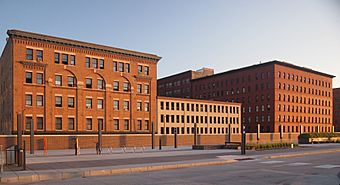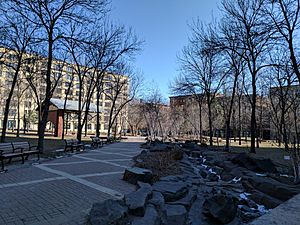Lowertown Historic District (Saint Paul, Minnesota) facts for kids
Quick facts for kids |
|
|
Lowertown Historic District
|
|

Commercial buildings of the Lowertown Historic District
|
|
| Location | Roughly bounded by Kellogg Blvd, Broadway, 7th, and Jackson Sts., Saint Paul, Minnesota |
|---|---|
| Area | 35.5 acres (14.4 ha) |
| Built | 1870–1921 |
| Architect | Multiple |
| Architectural style | Late 19th and 20th Century Revivals, Late Victorian |
| NRHP reference No. | 83000935 |
| Added to NRHP | February 21, 1983 |
The Lowertown Historic District is a special area in the Lowertown neighborhood of Saint Paul, Minnesota. It's like a time capsule of old buildings. This district covers 16 city blocks. It has 37 important buildings that were built between the 1870s and 1920s.
This area was added to the National Register of Historic Places in 1983. It was recognized for its important connections to the river and railroads. It also played a big role in the economy. The buildings show interesting architecture and city planning. Lowertown was the first main port on the Mississippi River. It was the entry point to the Twin Cities. Many warehouses, railroad offices, banks, and distribution centers served the entire Upper Midwest from 1880 to 1920. A lot of these old buildings are still standing. They share similar building styles and materials. Famous architects like Cass Gilbert and Clarence H. Johnston Sr. designed many of them.
Contents
Lowertown's Past: A Look at Its History
After the Great Depression, the Lowertown neighborhood became less active. But in the late 1960s, people started to notice its potential. The renovation of the Merchant's National Bank Building was one of the first projects. It helped bring attention back to the area. Soon after, the Noyes Brothers and Cutler Building was also updated. It became a place with offices, shops, and restaurants.
In 1973, the city's Housing and Redevelopment Authority (HRA) got involved. They helped redesign Mears Park. In April 1978, the Lowertown Redevelopment Corporation (LRC) was formed. Their goal was to make Lowertown a lively "urban village." They wanted to bring new jobs, homes, businesses, and activities. The McKnight Foundation gave them a large grant of $10 million. This helped the LRC lead the effort to bring Lowertown back to life.
During the 1970s and 1980s, many artists moved to Lowertown. They liked the low rents and quiet, open spaces. These artists helped bring new energy to the buildings and streets. The LRC and the City of St. Paul worked together. Lowertown was listed on the National Register of Historic Places in 1983. The next year, the city named it a Heritage Preservation Site.
Bringing Lowertown Back to Life: Redevelopment Efforts
Being named a historic district helped Lowertown get special tax credits. These credits made it easier to fix up old buildings. Artspace, the LRC, and the City worked together. They renovated three buildings for artists. These were the Lowertown Artists Lofts Cooperative, the Tilsner, and the Northern Warehouse. These buildings became important centers for the arts community.
Over the years, there has been a steady effort to improve Lowertown. Instead of tearing down old buildings, they chose to restore them. This slow and careful approach helped Lowertown stay a quiet neighborhood. It also supported the artists who lived there. It respected their financial and environmental needs.
In 1982, the St. Paul Farmers’ Market moved to Lowertown. This market has been around since the late 1800s. It became a popular spot in the quiet neighborhood. Now, about 20,000 people visit the market every weekend in the summer. In 2006, the LRC changed its name to the Lowertown Future Fund. It continues to support Lowertown's growth.
New homes have been built in the neighborhood. This has brought in new residents. Restaurants, festivals, and other attractions have also opened. The restored Union Depot is one example. The St. Paul Art Crawl happens twice a year. It shows off the cultural spirit that residents have worked hard to keep. In 2013, USA Today called Lowertown one of the "10 up-and-coming neighborhoods around the USA." This was after it was named a top "hipster zip code" by RealtyTrac. This means it has many young adults who use public transportation and rent their homes.
In 2015, the St. Paul Saints professional baseball team started playing in their new home. This new stadium is called CHS Field. It was built where the old Gilette/Diamond Products plant used to be. Local artists created art installations for the outside of the ballpark. CHS Field is just outside the official historic district. The district is generally bounded by Kellogg Boulevard, Broadway, 7th Street, and Jackson Street.
Mears Park: A Green Space in the City
Mears Park has had a few different names over time. It was once called Smith Park, Park Square, and Baptist Hill. The park is located between 5th, 6th, Sibley, and Wacouta streets. Long ago, the First Baptist church was built on a hill in this spot. In 1849, a man named Robert Smith gave the land to the city. This happened after the church moved to a new location. The hill was leveled, and the park was officially created in 1888.
For almost 100 years, the park was a typical city square. It had a fountain in the middle and sidewalks leading out from it. In the early 1970s, the park was called the “Brickyard.” This was because a renovation covered much of it with bricks. After he passed away in 1974, the park was officially renamed after Norman Mears. He was an inventor from St. Paul. His inventions helped during World War II and with color televisions. After retiring, Mears wanted to help bring Lowertown back to life.
The Mears Park we see today opened in 1992. It was rebuilt by landscape architect Don Ganje and artist Brad Goldberg. The new design was praised for mixing natural and man-made things. It has a rocky stream and a metal bandshell. The park is very popular year after year. Today, it is in the middle of a lively Lowertown. It hosts many fairs and festivals. These include Music in Mears, the Twin Cities Jazz Festival, and the Concrete and Grass Music Festival. Volunteers called the Friends of Mears Park help take care of the gardens.
Crane Ordway Building: From Industry to Homes
Crane and Ordway was a company that made parts for steam engines. These included valves, fittings, and other supplies. Rogers and Ordway was an older company that came before it. The Crane Company was once the biggest maker of these parts in the world. They had over 3,000 workers at their factory in Chicago. In 1892, Crane bought another company in Minneapolis.
On January 1, 1893, Richard T. Crane and Lucius Pond Ordway started the Crane & Ordway Company. They brought together several companies in the Northwest. Lucius Ordway became the vice president and general manager. He had moved to Saint Paul in 1883.
The company sold many items. These included pipes, fittings, boilers, and pumps. They also sold equipment for drilling wells and large irrigation systems. They even designed complete plans for water works. Later, Crane became part of American Standard Brands. Lucius Ordway went on to help build the 3M company.
The Crane Ordway building was finished in 1904. It was designed by Reed and Stem. This architectural firm also designed Grand Central Terminal in New York. The building was empty for 30 years. Then, Aeon, a non-profit group, restored it in 2006. This historic warehouse now has 70 affordable apartments for rent.
Union Depot Train Station: A Hub for Travel
Union Depot is a historic train station in Lowertown. It is a major transportation center. You can catch light rail, intercity trains, and buses there. It connects different ways of traveling in and out of Saint Paul.
Architects of Lowertown
Many talented architects helped shape the Lowertown neighborhood. Some of these include Cass Gilbert, J. Walter Stevens, and Charles Sumner Frost. Their designs helped create the unique look of the area.





